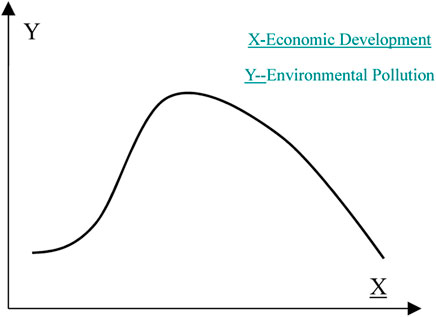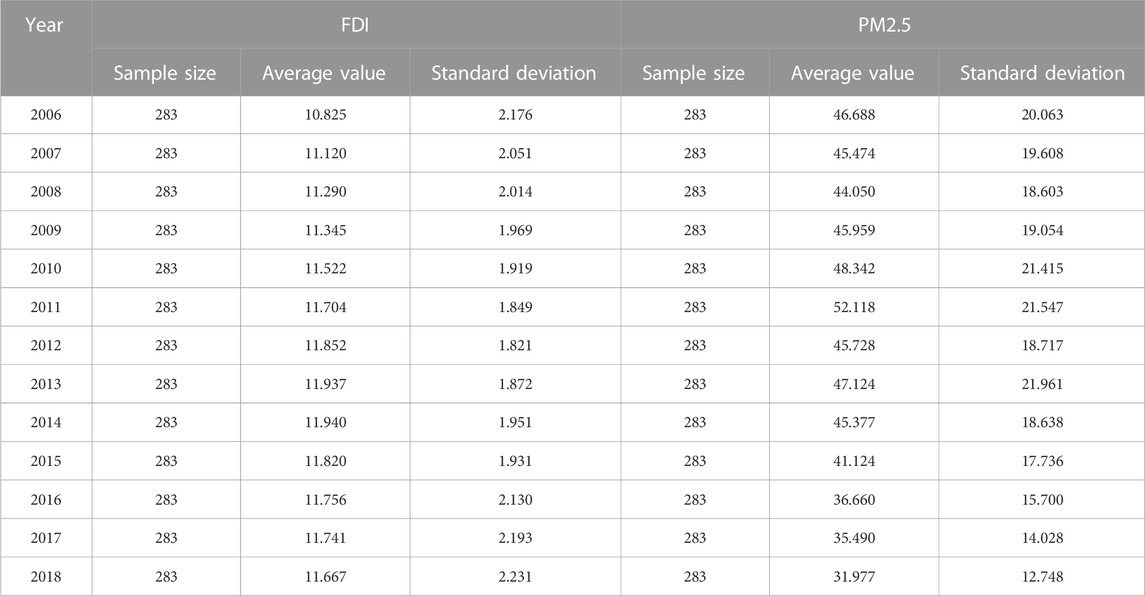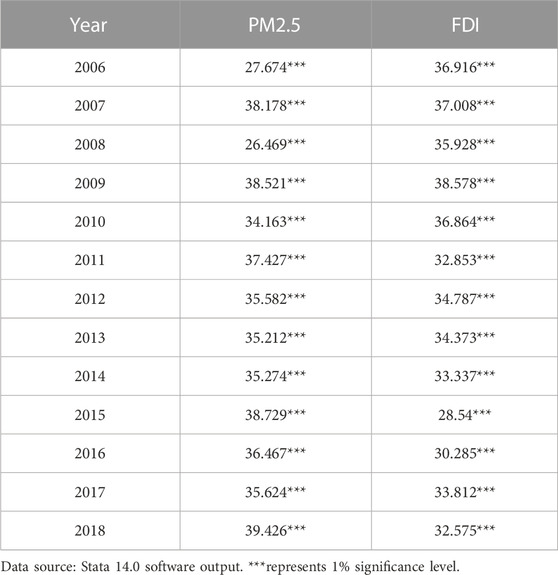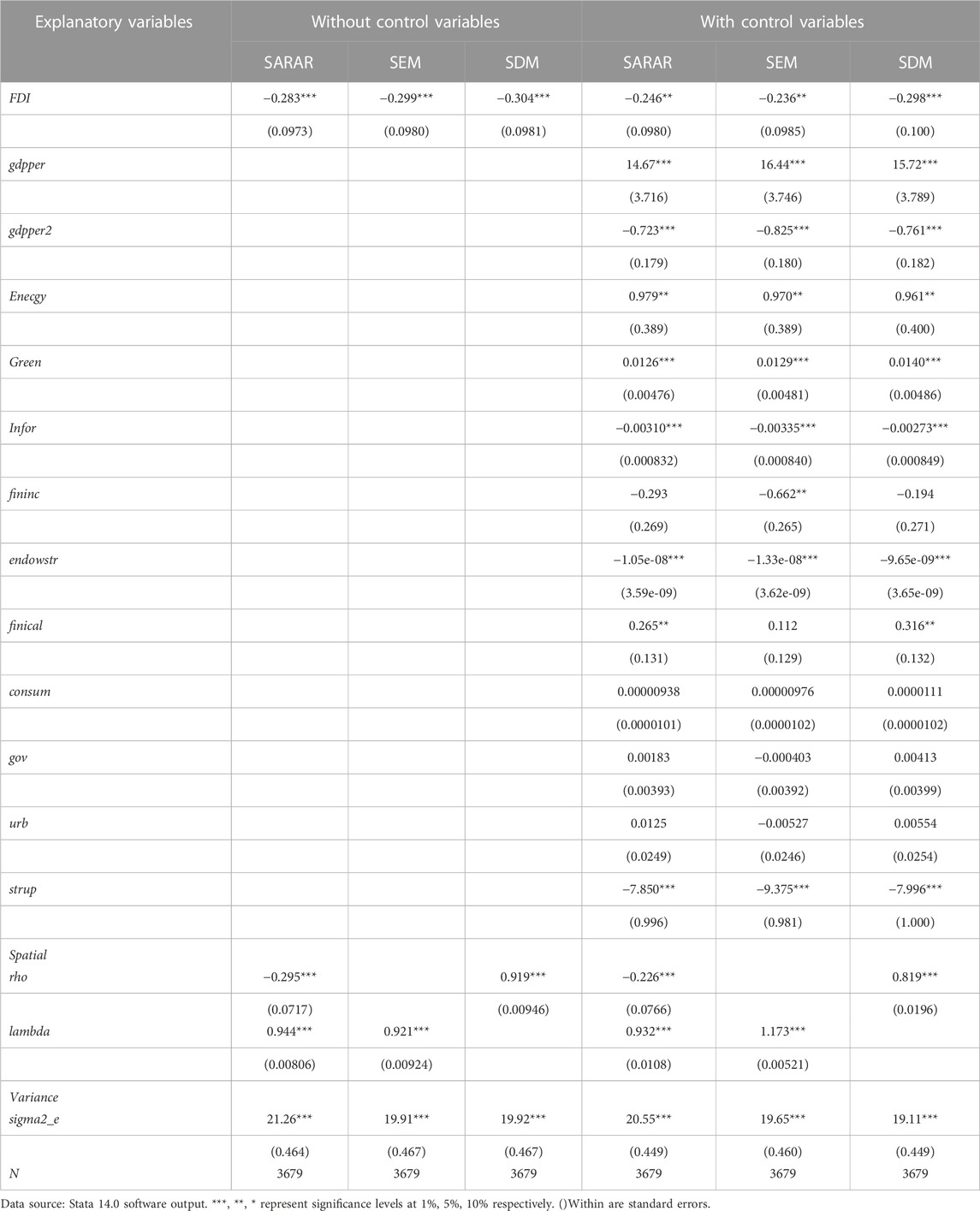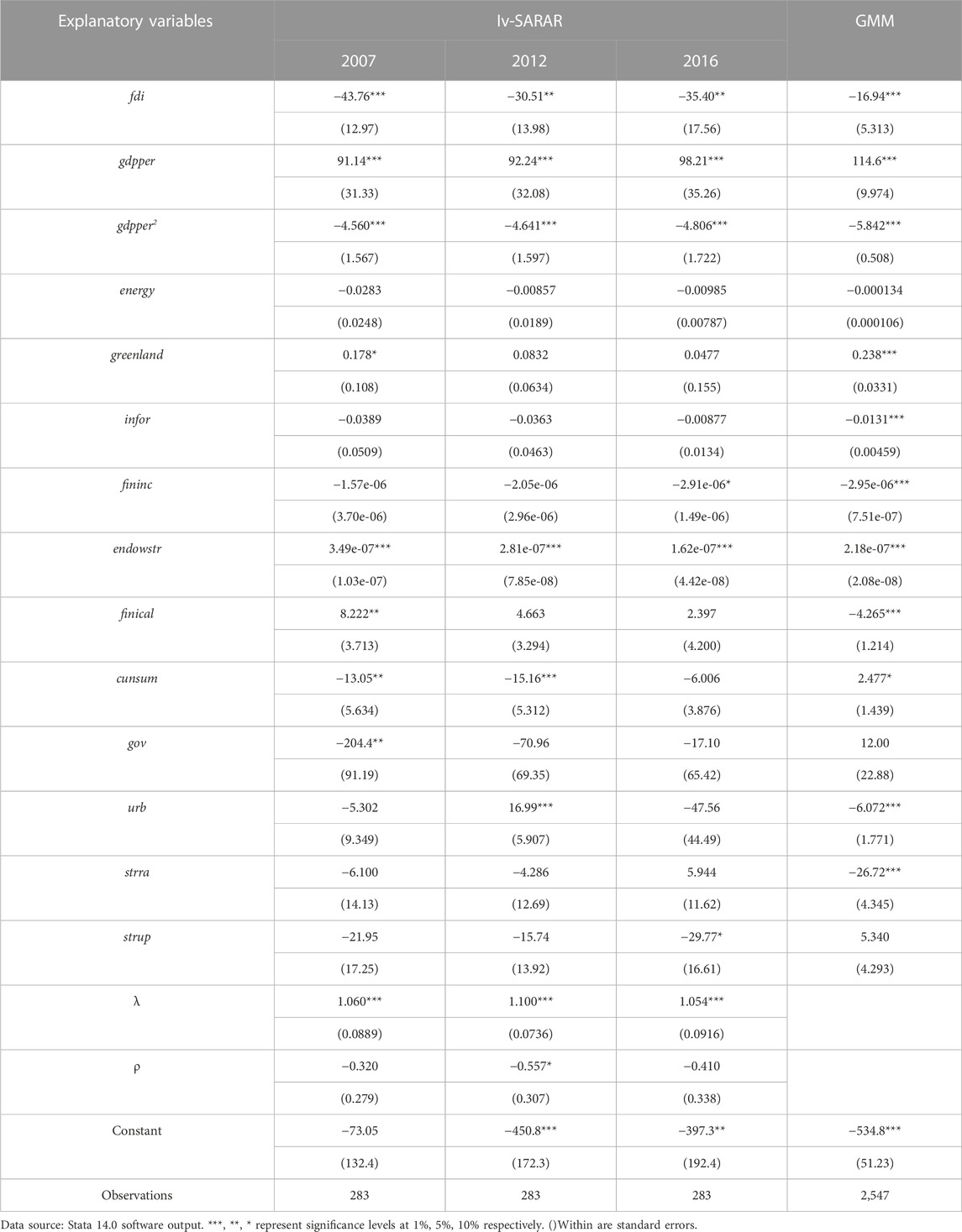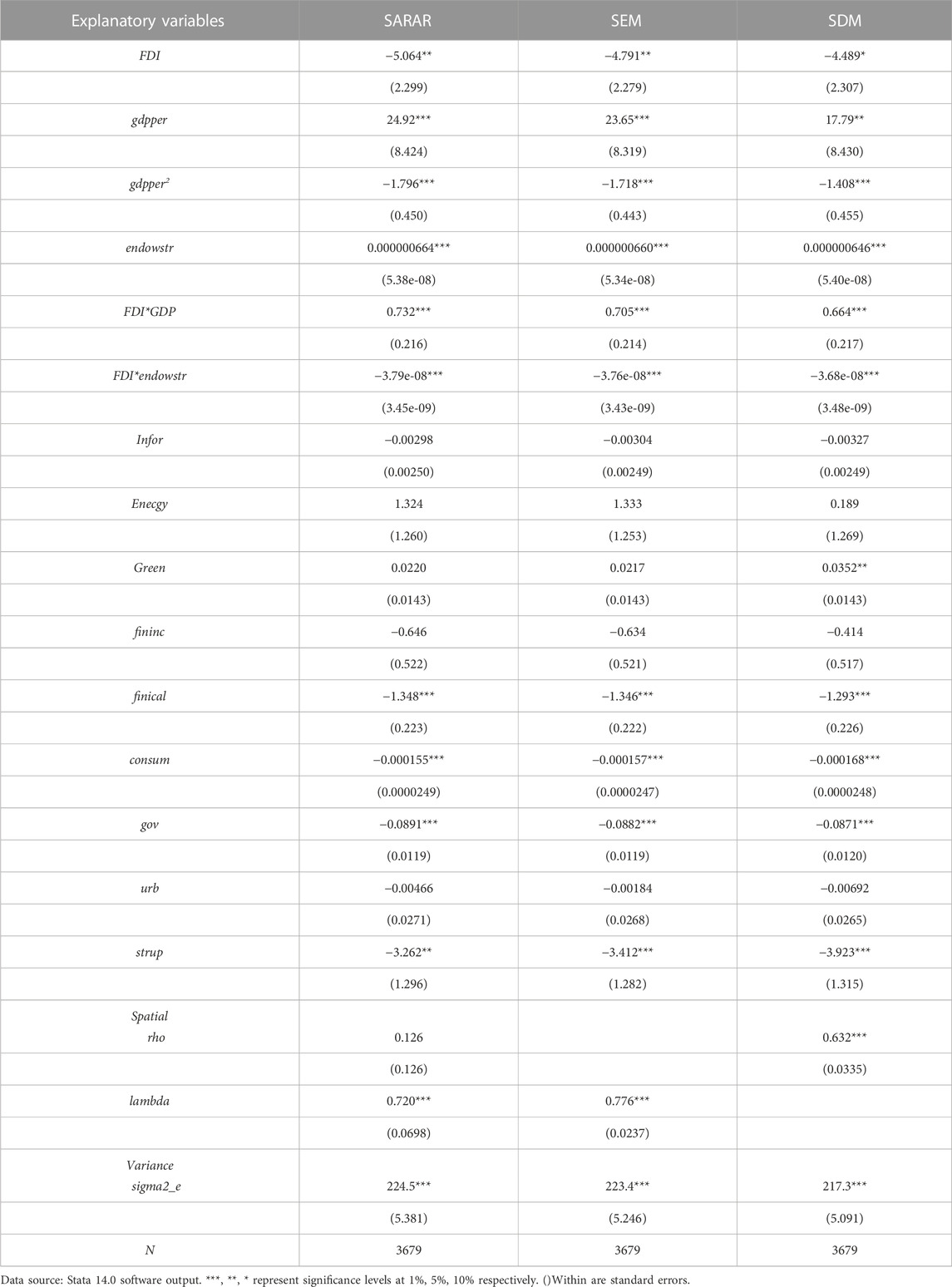- 1School of Management, Shenyang University of Technology, Shenyang, China
- 2Institute of Higher Education, Shenyang Agricultural University, Shenyang, China
This paper constructs a spatial econometric model based on the environmental Kuznets curve to examine the effect of foreign direct investment (FDI) on urban haze pollution in Chinese cities. The evidence from the raster data of PM2.5 concentration in MODIS and MISR shows that there is a significant spatial correlation between haze pollution and FDI in Chinese cities, which is expressed as a spatial spillover effect; FDI in Chinese mainland cities reduces haze pollution, which confirms the “pollution halo hypothesis”; using instrumental variable estimation, the above conclusions are still robust; The total effect of FDI on haze pollution is negative, and the total effect can be decomposed into scale effect, technology effect and structural effect; FDI increases urban haze pollution through scale effects and structural effect, but decreases urban haze pollution through technology effects; the environmental Kuznets curve exists in urban haze pollution in China, i.e., there is an inverted “U” relationship between economic development and haze pollution. This paper proposes that the establishment of inter-city linkage mechanism of haze control and the full play of the technical effect of FDI on haze pollution will help reduce urban haze pollution.
1 Introduction
In recent years, the widespread haze pollution problem in China has caused great concern among the government and residents. Some scholars point out that less than 1% of the top 500 cities in China have air quality that meets the World Health Organization standards (Georgiadis C and Patias P et al., 2022; Xu and Liu, 2022). Haze pollution is a concomitant of economic development, and that all economies experience environmental pollution in the early stages of industrialization, countries including the United States, Japan and Europe have experienced severe haze pollution in the last century (Feng and Wang, 2019).
China surpassed the United States in 2014 to become the country that attracts the most foreign direct investment (FDI) in the world. FDI has both positive and negative effects on environmental damage and haze pollution: first, local governments, in order to attract more foreign capital inflows, it tends to relax environmental regulations, accelerate the development and use of natural resources and produce more pollution-intensive products, and thus become a “Pollution paradise” for developed countries (CO L., 2000; Ahmed and Fatimah, 2012), this is known as the Pollution Haven Hypothesis (Brian and Taylor, 1994). The range of studies available includes Russia, Saudi Arabia, Oman Qatar (Saddam A, Kari F., 2014) and some African countries (Kivyiro P., Arminen H., 2014), of course, many other countries and regions. In the case of China, there is also some evidence to support the “pollution paradise hypothesis,” including inter-provincial and industry data. For example, Huang and Zhong et al. (2021) found a positive relationship between foreign direct investment and inter-provincial haze pollution in China; Ren et al. (2014) used Chinese industry data to investigate the relationship between FDI and carbon emissions and found a significant positive relationship between FDI and carbon emissions. In addition to the impact on a specific environmental indicator, some studies have also found a negative impact of FDI on the overall environmental quality. Scholars have even proposed the “bottom-up competition” hypothesis to support and explain the “pollution paradise hypothesis”: some less developed countries or regions will actively lower their environmental protection standards and requirements to compete for FDI at the expense of resources and the environment, and empirical studies have also found that local governments play a competitive game in attracting FDI, and that environmental regulation is significantly related to the level of FDI (Fahad S and Bai et al., 2021).
Second, FDI can improve the environmental welfare of the host country by introducing environmentally friendly technologies and products, and foreign-funded enterprises usually implement uniform environmental standards (Letchumanan and Kodama, 2000; Werner et al., 2001). Therefore, scholars put forward the “Pollution Halo Hypothesis,” that is, FDI can bring more advanced and environment-friendly technology to the host country and help to reduce the environmental Pollution of the host country (Nancy and David, 1993; Reppelin-hill V., 1999). The literature has carried out an empirical test of the “Pollution Heaven Hypothesis” and provided relevant evidence from different angles, but unfortunately, the relevant research conclusions are not consistent. Theoretically, the impact of FDI on the environment consists of three types of effects: first, the scale effect, second, the structural effect, and third, the technology effect (Krueger A B., 2000; Zhiqiang, 2006; Yuanyuan et al., 2017). Generally speaking, the scale effect caused by the increase in resource factor inputs resulting from FDI will increase environmental pressure, while the technology effect brought about by FDI will reduce the pressure on the environment, and the structural effect depends on the specific FDI quality and the industrial structure and economic development level of the host country (Tao et al., 2020). Therefore, the impact of FDI on the environment, such as haze pollution or carbon emissions, needs to be empirically analysed, and different findings may exist for different research subjects and different stages of economic development.
The main difference between haze pollution and other pollution is its strong mobility (LV Yanqin et al., 2022). Haze pollution is not a local environmental problem, it can spread or transfer to neighboring regions through natural factors such as atmospheric circulation, and economic mechanisms such as industrial transfer, industrial agglomeration, and traffic flow, therefore, the influence of FDI on haze pollution may not be the same as other pollution. In addition, due to the strong mobility of haze pollution, the relevant literature mainly adopts the spatial econometric model, including Spatial Dubin Model (SDM), Spatial Error Model (SEM) and Spatial Autoregressive Model (Sar) (Wang X et al., 2022; Sun Xianming et al., 2023), however, some scholars point out that spatial delay and spatial error may exist simultaneously in spatial model, so a new model considering both spatial error and spatial delay is proposed in recent literature, the Spatial Lag Model with spatial lag error term (SARAR) has not been used to analyze it in the literature.
In the literature on FDI’s contribution to haze pollution in China, the existing data mainly used provincial or provincial capital city data, and lacked the authoritative data covering the whole country. In this paper, a spatial panel data model was developed to test the “Pollution paradise hypothesis” and “Pollution halo hypothesis” using MODIS and MISR raster data of PM2.5 concentrations at the Chinese mainland city level, the SARAR Model is used to test the effect of FDI on haze pollution, and found that FDI reduces haze pollution through technological effect.
The contribution of this paper is to analyze the effect of FDI on haze pollution by using the grid data of PM2.5 concentration at city level, and to analyze the mechanism, this study provides new evidence for the controversy of “Pollution heaven hypothesis” and “Pollution halo hypothesis”. The second part is the literature review, the third part introduces the model and data, the fourth part is the analysis of empirical results, and the last is the conclusion and discussion.
2 Models and data
2.1 Model
Most of the econometric modelling related to the analysis of environmental pollution in an economy is based on the Environmental Kuznets Curve (EKC). The Environmental Kuznets curve (Figure 1) points out that the environmental quality of an economy will gradually improve at the initial stage with the level of economic development of the economy, but when the economic development of an economy reaches a certain level, the improvement of the structure and quality of economic development will gradually change the environmental quality, so the relationship between economic development and the environment shows an inverted “U” shape (Song and Ye, 2021). In the process of econometric analysis, the verification of the inverted “U” curve is mainly carried out by adding a quadratic term to the linear model, thus, the literature analysing the impact of FDI on environmental development is mainly based on the level of economic development and its quadratic term by adding the FDI variable to the analysis.
In addition, as FDI and haze pollution may be spatially correlated, traditional panel data models that do not take spatial factors into account may cause unreliable research findings due to the correlation of error terms, so this paper will establish a spatial econometric model to verify the concerns of this paper (Gan and Yang, 2020). In terms of specific model adoption, spatial econometric models mainly include include Spatial Dubin Model (SDM), Spatial Error Model (SEM) and Spatial Lag Model (SLM, also known as Spatial Autoregressive Model, SAR). In this paper, the spatial fixed effects of choice were determined according to the LM and LR tests, and the SEM model and SAR model were determined to be more effective than the SDM model according to the Wald test. But since the spatial lag term and the spatial error term of a spatial model may co-exist, new literature has proposed models that can consider both spatial error terms and spatial lag terms, i.e., spatial lag models with spatial lag error terms (SARAR), and in this paper the SARAR model is used for the analysis. The SARAR model takes the following specific form:
In Eq. 1,
Expanding Eq. 1 according to the environmental Kuznets curve (EKC) to create the SARAR model for this paper:
In Eq. 2, i represents the ith sample, t represents the tth year,
In addition, drawing on the existing literature, the following control variables are considered:
The first is the energy intensity indicator. The process of haze pollution formation is complex, and industrial energy consumption is an important trigger of haze pollution (Zhou and Yin, 2022). The second is the green space coverage. One of the causes of haze pollution is dust from construction sites, motor vehicle exhaust emissions, industrial production emissions, coal-fired exhaust emissions from thermal power stations, etc. Green areas help to absorb various dust and other toxic substances from the various emissions mentioned above (Meo and Almutairi et al., 2021). The third is the factor endowment structure (Feng and Cheng-gang, 2018). The factor endowment structure determines the type of technological progress in an economy and therefore affects haze pollution from the perspective of technological progress. The fourth is the size of government, including indicators of fiscal budget revenue and fiscal expenditure share. The government plays an important role in environmental monitoring and governance, and there may also be an impact of government size on haze pollution (Li et al., 2020). The fifth is the indicator of industrial structure, including the indicator of advanced industrial structure and rationalization of industrial structure. Haze pollution differs at different stages of industrial development. For example, at the early stage of industrialisation, the development of cement, iron and steel, electrolytic aluminium and other industries will increase haze pollution, but as the industry continues to upgrade and the proportion of service industry rises, haze pollution will gradually decline (Shi and Zhang, 2021). The Sixth is urbanisation level indicators. The rising level of urbanisation will increase the consumption of housing demand, household appliances and household cars, while the real estate industry and automobile exhaust emissions, etc. are important sources of urban haze pollution. Elevated electricity consumption from household appliances will also increase coal consumption, which in turn increases the source of haze pollution (Liu et al., 2019). Other control variables include the level of consumption, the level of information technology, and the level of financial development (Huang and Guo, 2021; Wang Xiong et al., 2023).
Ultimately, the SARAR model in this paper takes the following form:
The control variables are:
2.2 Data
The research object of this paper is cities at the prefecture level and above in mainland China. The total number of prefecture-level cities and above in mainland China is 295 (including four municipalities directly under the central government, 15 sub-provincial cities, etc.). In order to ensure data continuity for the construction of balanced panel data, prefecture-level cities with changed administrative units (e.g., Chaohu City, etc.) and some cities with serious data deficiencies (e.g., Lhasa City, Zhongwei City, Longnan City, etc.) were removed from this study. In addition, Haikou and Sanya are located in Hainan Province, the island province, and are not connected with any other cities in the ground. Considering the construction of the spatial weight matrix, Haikou City and Sanya City in Hainan Province were removed from this paper, leaving a final sample size of 283. In this paper, considering the availability of maps required for haze data, the time frame of the study is 2006–2018.
The data sources for this paper include two aspects:
The first is haze data. The haze data in this paper come from the Centre for International Earth Science Information Network Pathways (CIESIN) at Columbia University, United States, which relies on the Socio-Economic Data and Applications Center (SEDAC) to publish satellite-borne Moderate Resolution Imaging Spectroradiometer (MODIS) and Multi-angle Imaging Spectroradiometer (MISR) measurements to obtain aerosol optical thickness images that can be converted to obtain PM2.5 concentration raster data. In this paper, ArcGIS software was used to parse this data into PM2.5 concentration data for cities above the prefecture level in mainland China. To eliminate fluctuations, a 3-year sliding average was used in this study.
Second, FDI and other urban economic variables. The raw data were mainly obtained from the collation and measurement of the China Urban Statistical Yearbook and the China Regional Economic Statistical Yearbook from 2003 to 2013, and the data of each price deflator were obtained from the provincial and municipal statistical yearbooks of the corresponding years and provinces.
The quantification methods for each variable are: FDI is the logarithm of the level of foreign direct investment; economic development level variables are quantified using GDP (Gross Domestic Product) per capita, with the squared economic development level term being GDP per capita squared; limited to data availability, energy intensity indicators are quantified using GDP output per unit of industrial electricity consumption; green space coverage is quantified using the green coverage of built-up areas (%); urban factor endowment structure is quantified using the average labour capital stock, and the capital stock is calculated using the perpetual inventory method, with the specific process drawing on Swapnil S., M H Bala. (2019) fiscal budget revenue is quantified using local fiscal general budget revenue; fiscal expenditure share is quantified using local fiscal general budget expenditure as a proportion of GDP (%); financial development indicators are quantified using year-end (%); the indicator of urban consumption level adopts the quantification of total retail sales of social consumer goods per capita; the indicator of urbanisation development level adopts the quantification of urbanisation rate indicator; the indicator of information development level adopts the quantification of international internet users (households). The formula for the index of advanced industrial structure is:
2.3 Descriptive statistics of FDI and changes in haze pollution in Chinese cities
The descriptive statistics of the data show that during the period 2006–2018, FDI and PM2.5 in mainland Chinese cities maintained an upward trend until 2012 and began to gradually decline after 2012, which may be related to the slowdown in growth of the Chinese economy as a whole after the second financial crisis in 2011, and the fluctuations in economic activities have caused fluctuations in haze pollution.
3 Results of the empirical analysis
3.1 Testing the effect of FDI on haze pollution
In this paper, the correlation model is estimated using the Stata 14.0 software and the maximum likelihood method.
Before conducting the spatial measurement test, it is necessary to test the spatial correlation of the relevant variables. In this paper, the Moran’s I index, which has been used more frequently in the literature, is selected for testing (Zhang, 2020), and the Moran’s I is calculated as follows:
In Eq. 4,
From the test results of Moran’s I index, the haze pollution among Chinese cities shows a significant spatial correlation, with all positive values of Moran’s I index, indicating that this spatial correlation reflects a spatial spillover effect. Firstly, the similarity of variables such as factor endowment, economic development level and industrial structure level between neighbouring cities may lead to the close probability and quantity of haze pollution generation, resulting in this spatial correlation. Secondly, haze pollution is strongly influenced by climatic variables such as wind direction after formation, so haze between neighbouring cities may appear to flow into each other, resulting in spatial correlation and spatial spillover. There is also a significant spatial correlation of FDI between cities, which also manifests itself as a spatial spillover effect. When looking for a destination city, foreign direct investment may take into account factors such as resource endowment, geographical location, technology stock, talent pool and market size, and the above variables are more consistent between neighbouring cities, thus possibly resulting in similar decisions on foreign direct investment and the emergence of a spatial correlation of FDI between cities.
In this paper, the SARAR model (benchmark model) is used to test the effect of FDI on haze pollution, and in the process of analysis, the estimation results of both SEM and SDM models are given to demonstrate the robustness of the findings. Moreover, the estimation results of the model including control variables and the estimation results of the model without control variables are also presented, as shown in Table 3.
From the model estimation results, the spatial error coefficients and spatial lag coefficients of all six models are significant (at 1% significance level), proving the spatial correlation between urban haze pollution in mainland China, echoing the test results of Moran’s I index, and proving the necessity and scientificity of using spatial econometric models.
From the six model estimation results, FDI passed the significance level test on haze pollution in the sample cities with negative estimated coefficients, indicating that FDI has a significant reduction effect on haze pollution, i.e., confirming the “pollution halo hypothesis,” indicating that the “pollution paradise hypothesis” is not valid in urban haze pollution in China. This is consistent with the findings of Guo and Tang et al. (2015) for the Pearl River Delta region. With the development of China’s urban economy, the scarcity of capital factors is gradually decreasing, so cities do not need to lower their environmental protection standards in the process of attracting investment, but selectively introduce foreign investment, FDI may have more advanced production technology and environmental protection technology, which can reduce the average energy consumption of economic output and also help improve environmental quality. The fundamental measure to reduce haze pollution is to change the mode of economic growth, optimise the industrial structure and improve the quality of economic growth, and FDI can play an important role in this process. Theoretically, the impact of FDI on haze includes the scale effect, technology effect and structural effect, and the specific paths of the three different mechanisms will be further discussed in later sections. It should be noted that this conclusion holds for the urban sample only, for the county sample, it is possible that due to the higher scarcity of capital, each county government will be less demanding in terms of environmental protection when attracting investment, and therefore the effect of FDI on its haze may have inconsistent findings, which is a separate story and will not be discussed further.
The model results also show that the impact of economic development indicators on haze pollution also passes the significance test, with positive coefficients on the primary term and negative coefficients on the secondary term, indicating an inverted “U” relationship between economic development and haze pollution, i.e., the environmental Kuznets curve holds true for urban haze pollution in mainland China. During the period of low economic development, economic growth is mainly supported by factor inputs and the industrial structure is mainly concentrated in low-end industries, all these factors determine that economic growth will increase the emission of haze pollution sources; however, as the economy grows further, the industrial structure is continuously optimised and the technical efficiency is continuously improved, the emission of pollution caused by economic growth will decrease. This inference is reflected in the estimated results of the industrial structure indicator. At present, China’s economic development is mainly supported by industrialisation, so the share of non-agricultural industries is gradually increasing along with the emissions of haze pollution sources. However, from the industrial structure rationalization indicator, the optimization and upgrading of industries will change the structure and total energy consumption of the regional economy, which will also reduce haze pollution from the perspective of technological progress. The estimated results of other control variables are not discussed.
3.2 Robustness discussion
It has been found in the literature that there may be a causal relationship between FDI and environmental pollution, i.e., host countries may actively lower their environmental standards in order to attract FDI, which is also the “bottom-up competition” hypothesis and therefore may cause endogeneity problems in the model. Drawing on the existing literature, this paper re-estimates the model by choosing a one-period lagged variable of FDI as the instrumental variable of FDI.
Since the SARAR model is only ordered for the estimation of instrumental variables for cross-sectional data, this paper chooses to present the estimation results of the iv-SARAR model for 2007, 2012 and 2016, as well as the estimation results of the GMM model for 2007–2016 with the one-period lagged variable of FDI as the instrumental variable. The results are shown in Table 4.
The results of the 3-year iv-SARAR model also show that the estimated impact of FDI on haze pollution passed the significance test with a negative coefficient, demonstrating that FDI can effectively reduce urban haze pollution, which is consistent with the estimation findings of the baseline model. The primary term of the economic development indicator is significantly positive and the secondary term is significantly negative, indicating that the inverted “U” shaped relationship between economic growth and haze pollution still holds after taking into account the endogeneity issue.
As the iv-SARAR model only provides cross-sectional evidence, the results of the GMM estimation are also presented in this paper. The results of the endogeneity test, the weak instrumental variable test and the over-identification test are not presented for the sake of space. From the GMM estimation results, the coefficients and significance of the core explanatory variables are similar to those of the benchmark model: the coefficient of the effect of FDI on haze pollution is significantly negative, and the primary term of the economic development indicator is significantly positive and the secondary term is significantly negative.
3.3 Further discussion: Testing the mechanism of FDI’s influence on haze pollution
To examine the mechanism of FDI’s influence on urban haze pollution, this paper constructs interaction terms between FDI and two variables: economic development and factor endowment structure (labour-average capital, which has been used as a proxy variable for technological progress in the literature), based on the scale effect and technology effect. Specifically, the scale effect variable in this paper is the product of the logarithm of FDI and GDP and the technology effect variable is the product of FDI and the indicator of labour-average capital. This paper adds the above two interaction terms to the baseline SARAR model, while the results of models with other control variables and models without other control variables are presented in this section to reflect the robustness of the findings, with each type of model results including SARAR models, SEM models and SDM models. The results are shown in Table 5.
After adding the two interaction terms mentioned above, the FDI indicator and the economic development and economic development squared indicators are consistent with the results of the benchmark model and all pass the significance test, further validating the robustness of the paper’s findings.
From the estimation results of the model, the scale effect indicator is significantly positive and the technology effect indicator is significantly negative, which is consistent with the findings of the existing literature and in line with theoretical expectations. The estimation results of the model show that the structural effect of FDI on haze pollution is significantly negative, providing new evidence for the literature.
Firstly, FDI increases urban haze pollution through the scale effect. First, the productive capacity created by FDI leads to an increase in the input of relevant factors of production in cities, which will consume more energy and increase the source of haze. Second, FDI will increase the concentration of labour and other factors in cities, which will increase the demand for living things such as cars, home appliances and housing, and the related industries are all important sectors as sources of haze pollution. Secondly, FDI reduces urban haze pollution through the technology effect. It has been shown in literature that FDI can improve the technical level and production efficiency of cities through the introduction of technology and the improvement of management level, so FDI will reduce the energy consumption and pollution emissions per unit of production in cities.
But in combination, the technology effect (growth effect) brought by FDI outweighs the scale effect, so the combined effect of FDI on urban haze pollution reflects a negative effect, i.e., FDI reduces urban haze pollution.
4 Conclusion and discussion
In reality, the seriousness of urban haze pollution in China has attracted much attention from the government and people; in theory, there are debates between the “pollution paradise hypothesis” and the “pollution halo hypothesis” on the impact of FDI on the environment, and the findings of relevant empirical studies are inconsistent. This paper compiles panel data on haze pollution in 283 cities in mainland China, providing new evidence on PM2.5 pollution for the “pollution halo hypothesis”. Based on the raster data of PM2.5 concentrations in MODIS and MISR, this paper constructs a spatial econometric model based on the environmental Kuznets curve to examine the effect of FDI on haze pollution and finds that FDI in mainland Chinese cities reduces haze pollution. iv-SARAR model and GMM model are used as instrumental variables to find that the findings are still robust using the lagged one-period FDI data.The mechanism of impact on haze pollution includes two effects: FDI increases urban haze pollution through scale effects, but reduces urban haze pollution through technology effects. The paper also finds that there is a significant spatial correlation between haze pollution and FDI in Chinese cities, which is manifested as a spatial spillover effect; the environmental Kuznets curve is present in haze pollution in Chinese cities, i.e., there is an inverted “U” relationship between economic development and haze pollution.
The policy implications of the findings of this paper are obvious and important, as haze pollution is a common problem at a particular stage of development, but appropriate strategies can help to reduce urban haze pollution: firstly, to build an inter-city linkage mechanism for haze prevention and control based on the correlation between haze pollution between cities; secondly, to improve the quality of foreign investment introduction and give full play to the technological effect of FDI on haze pollution to reduce urban haze pollution.
The limitation of this study is the unmatched enterprise data for mechanism testing. In reality, the effect of FDI on haze pollution is mainly through the effect of corporate decision-making, and corporate behavior decision-making affects the size of haze pollution emissions. However, the issue of Enterprise’s pollution discharge is very sensitive, so the authenticity of the data is worth discussing. In the future, if we can get real emission data of enterprise haze pollution sources, further empirical analysis is of great significance. Another limitation is that meteorological factors (wind speed and direction, rain) are not considered in this study. Meteorological factors may also greatly affect PM2.5 levels, in the future, relevant data will be collected to further analyze the impact of meteorological factors on haze pollution.
Data availability statement
The original contributions presented in the study are included in the article/supplementary material, further inquiries can be directed to the corresponding author.
Author contributions
YL presented the study and critically revised its important elements. MG supervised the data collection, performed the preliminary analysis, and reviewed and revised the manuscript. All authors read and approved the final manuscript.
Conflict of interest
The authors declare that the research was conducted in the absence of any commercial or financial relationships that could be construed as a potential conflict of interest.
Publisher’s note
All claims expressed in this article are solely those of the authors and do not necessarily represent those of their affiliated organizations, or those of the publisher, the editors and the reviewers. Any product that may be evaluated in this article, or claim that may be made by its manufacturer, is not guaranteed or endorsed by the publisher.
References
Ahmed, S., and Fatimah, K. (2014). A long-run dynamic analysis of FDI, growth and oil export in GCC countries: An evidence from VECM model. Can. Soc. Sci. 10. doi:10.3968/j.css.1923669720141001.4214
Ahmed, S., and Fatimah, K. (2012) Size of Economy, Cost of Transport and their impact on Trade in GCC countries: Evidence from qualitative and quantitative approaches J. Finance Invest. Analysis 1, 1–8.
Brian, R. C., and Taylor, M. S. (1994). North-South trade and the environment. Q. J. Econ. 109, 755–787. doi:10.2307/2118421
Fahad, S., Bai, D., Liu, L., and Baloch, Z. A. (2021). Heterogeneous impacts of environmental regulation on foreign direct investment: Do environmental regulation affect FDI decisions? Environ. Sci. Pollut. Res. Int. 29, 5092–5104. doi:10.1007/s11356-021-15277-4
Feng, L. I., and Cheng-gang, L. I. (2018). “Factor endowment, institutional constraints and regional economic development potential——Empirical analysis based on the perspective of new structural economics,” in Proceedings of 2018 3rd International Conference on Computational Modeling, Simulation and Applied Mathematics (CMSAM 2018), 268–272.
Georgiadis, C., Patias, P., Verde, N., Tsioukas, V., Kaimaris, D., Georgoula, O., et al. (2022). State-of-play in addressing urban environmental pressures: Mind the gaps. Environ. Sci. Policy 132. doi:10.1016/j.envsci.2022.02.030
Hao, G., Jie, T., Dong, W., Furong, C., and Lianlian, L. (2015). Effects of FDI on environment pollution based on carbon dioxide emissions in the Pearl River Delta region. Nat. Environ. Polution Technol. 14.
Huang, D., Zhong, S., Tang, J., and Zhao, J. (2021a). Impact of foreign direct investment on the haze pollution in various cities: Evidence from China. GROWTH CHANGE 52. doi:10.1111/grow.12557
Huang, M., Guo, Z., and Guo, Y. (2021b). Socio-economic factors on haze pollution: Based on panel data of 30 provinces in China. IOP Conf. Ser. Earth Environ. Sci. 647, 012199. doi:10.1088/1755-1315/647/1/012199
John, A. L., and Catherine, Y. C. (1999). The effects of environmental regulations on foreign direct investment. J. Environ. Econ. Manag. 40, 1–20. doi:10.1006/jeem.1999.1095
Li, C., and Li, G. (2020). Does environmental regulation reduce China's haze pollution? An empirical analysis based on panel quantile regression. PLOS ONE 15, e0240723. doi:10.1371/journal.pone.0240723
Liu, X. (2019). Impact of urbanization on energy consumption and haze in China-A review. Energy Sources, Part A Recovery, Util. Environ. Eff. 44. doi:10.1080/15567036.2019.1648601
Lv, Y., Fan, T., Zhao, B., Zhang, J., Zheng, Y., and Zhang, Z. (2022). How do government environmental concerns affect haze pollution? Front. Env. SCI-SWITZ 10. doi:10.3389/fenvs.2022.945226
Meo, S. A., Almutairi, F. J., Abukhalaf, A. A., and Usmani, A. M. (2021). Effect of green space environment on air pollutants PM2.5, PM10, CO, O3, and incidence and mortality of SARS-CoV-2 in highly green and less-green countries. Int. J. Environ. Res. Public Health 18, 13151. doi:10.3390/ijerph182413151
Nancy, B., and David, W. (1993). Trade policy and industrial pollution in Latin America: Where are the pollution havens? J. Environ. Dev. 2, 137–149. doi:10.1177/107049659300200107
Pendo, K., and Heli, A. (2014). Carbon dioxide emissions, energy consumption, economic growth, and foreign direct investment: Causality analysis for Sub-Saharan Africa. ENERGY 74. doi:10.1016/j.energy.2014.07.025
Raman, L., and Fumio, K. (2000). Reconciling the conflict between the `pollution-haven' hypothesis and an emerging trajectory of international technology transfer. Res. POLICY 29, 59–79. doi:10.1016/s0048-7333(99)00033-5
Ren, X., Zeng, G., and Gozgor, G. (2023). How does digital finance affect industrial structure upgrading? Evidence from Chinese prefecture-level cities. J. Environ. MANAGE 330, 117125. doi:10.1016/j.jenvman.2022.117125
Shenggang, R., Baolong, Y., Xie, M., and Xiaohong, C. (2014). International trade, fdi (foreign direct investment) and embodied CO 2 emissions: A case study of chinas industrial sectors. CHINA Econ. Rev. 28, 123–134. doi:10.1016/j.chieco.2014.01.003
Song, W., Ye, C., Liu, Y., and Cheng, W. (2021). Do China’s urban–environmental quality and economic growth conform to the environmental Kuznets curve? Int. J. Environ. Res. Public Health 18, 13420. doi:10.3390/ijerph182413420
Sun, X., Xiao, S., Ren, X., and Xu, B. (2023). Time-varying impact of information and communication technology on carbon emissions. ENERG Econ. 118, 106492. doi:10.1016/j.eneco.2022.106492
Swapnil, S., Subrahmanya, M. H. B., and Puranjoy, B. (2019). Real capital stock estimation for industries using perpetual inventory method: A methodological exploration. Indian Econ. J. 67, 82–98. doi:10.1177/0019466220938009
Tao, S., Wei, Z., Qian, Z., and Kai, W. (2020). Industrial structure, urban governance and haze pollution: Spatiotemporal evidence from China. Sci. TOTAL Environ. 742, 139228. doi:10.1016/j.scitotenv.2020.139228
Ting, G., Huachao, Y., Wei, L., and Xianchun, L. (2020). Do economic development and population agglomeration inevitably aggravate haze pollution in China? New evidence from spatial econometric analysis. Environ. Sci. Pollut. R. 28, 5063–5079. doi:10.1007/s11356-020-10847-4
Valérie, R. (1999). Trade and environment: An empirical analysis of the technology effect in the steel industry. J. Environ. Econ. Manag. 38, 283–301. doi:10.1006/jeem.1999.1085
Wang, X., Li, J., Ren, X., Bu, R., and Jawadi, F. (2023). Economic policy uncertainty and dynamic correlations in energy markets: Assessment and solutions. ENERG Econ. 117, 106475.doi:10.1016/j.eneco.2022.106475
Wang, X., Wang, X., Ren, X., and Wen, F. (2022). Can digital financial inclusion affect CO2 emissions of China at the prefecture level? Evidence from a spatial econometric approach. ENERG Econ. 109.doi:10.1016/j.eneco.2022.105966
Werner, A., Brian, R. C., and Taylor, M. S. (2001). Is free trade good for the environment? Am. Econ. Rev. 91, 877–908. doi:10.1257/aer.91.4.877
Xu, Z., Liu, Z., Tian, J., Liu, Y., Pan, H., Liu, S., et al. (2022). Classification of urban pollution levels based on clustering and spatial statistics. ATMOSPHERE-BASEL 13. doi:10.3390/atmos13030494
Yanchao, F., and Xiaohong, W. (2020). Effects of urban sprawl on haze pollution in China based on dynamic spatial Durbin model during 2003–2016. J. Clean. Prod. 242. doi:10.1016/j.jclepro.2019.118368
Yuanyuan, H., En, X., Yu, L., and Reddy, K. S. (2017). Does state ownership facilitate outward FDI of Chinese SOEs? Institutional development, market competition, and the logic of interdependence between governments and SOEs. Int. Bus. Rev. 26, 176–188. doi:10.1016/j.ibusrev.2016.06.005
Zhang, Y. (2020). “Analysis of the spatial effects of inter-provincial air pollution in China,” in 5th International Conference on Advances in Energy and Environment Research, Shanghai, China, September 2020.
Zhiqiang, L. (2006). Foreign direct investment and technology spillovers: Theory and evidence. J. Dev. Econ. 85, 176–193. doi:10.1016/j.jdeveco.2006.07.001
Keywords: FDI, PM2.5, pollution paradise hypothesis, Kuznets curve, SARAR model
Citation: Liu Y and Guo M (2023) The impact of FDI on haze pollution: “Pollution paradise” or “pollution halo?”--Spatial analysis of PM2.5 concentration raster data in 283 cities. Front. Environ. Sci. 11:1133178. doi: 10.3389/fenvs.2023.1133178
Received: 28 December 2022; Accepted: 24 February 2023;
Published: 10 March 2023.
Edited by:
Xiaohang Ren, Central South University, ChinaCopyright © 2023 Liu and Guo. This is an open-access article distributed under the terms of the Creative Commons Attribution License (CC BY). The use, distribution or reproduction in other forums is permitted, provided the original author(s) and the copyright owner(s) are credited and that the original publication in this journal is cited, in accordance with accepted academic practice. No use, distribution or reproduction is permitted which does not comply with these terms.
*Correspondence: Mingshun Guo, c3V0Z21zQDE2My5jb20=
 Yanbo Liu1,2
Yanbo Liu1,2 Mingshun Guo
Mingshun Guo